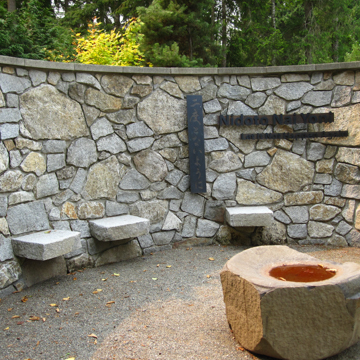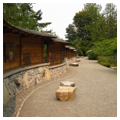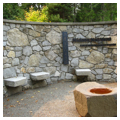On March 30, 1942, Bainbridge Island’s 227 Japanese American residents were removed from their homes and taken to the Manzanar War Relocation Center in California’s Central Valley. These island residents were the first of nearly 120,000 people of Japanese descent to be relocated to internment camps following the United States’ entry into World War II. The Bainbridge Island Japanese American Exclusion Memorial, designed by Johnpaul Jones, commemorates this event and recognizes the broader injustice of wartime internment policy. It also honors the community ties that brought two-thirds of the island’s Japanese American residents back to their homes after the war.
Agriculture and other booming industries pulled Japanese immigrants to the Pacific Northwest during the 1880s and 1890s. While thousands of immigrants settled in Seattle and elsewhere around Washington, some found their way to Bainbridge Island. By the 1910s, more than 200 Japanese men and women lived on the island. Many worked as farmers and specialized in the cultivation of strawberries and, despite discrimination during the 1920s and 1930s, built homes and businesses, started families, and eventually secured a measure of acceptance from their neighbors. But tensions increased between the U.S. and Japan during these decades, culminating in the Japanese attack on Pearl Harbor on December 7, 1941; calls for the removal of all people of Japanese descent from the West Coast ensued in the following weeks.
President Franklin D. Roosevelt answered these calls on February 19, 1942, when he authorized the Secretary of War to forgo due process and simply remove any “potentially dangerous” civilians from any places designated as military areas. The process began with Bainbridge Island, which housed the Fort Ward Naval Radio Station (used for monitoring Japanese military communications). The FBI had already arrested 15 of the island’s Japanese residents, 6 residents were serving in the U.S. military, and 28 residents left the island voluntarily before mid-March. On March 24, 1942, the remaining 227 residents were given six days to pack two suitcases, store or sell the rest of their belongings, and prepare for a trip to an unknown destination.
In its overall physical form, the Bainbridge Island Japanese American Exclusion Memorial evokes this day of departure. The memorial’s centerpiece is a sinuous, 276-foot-long wall—one foot for every exiled island resident. Constructed out of old-growth red cedar, granite, and basalt, the wall traces the path that 227 residents followed as they walked from a holding area on the south side of Eagle Harbor down to a ferry dock where they began an ordeal that would keep them from their homes for three years, if not forever.
But the memorial is also a reminder that this day of departure was meaningful for the entire community. Indeed, many of Bainbridge Island’s white residents came to show their support for their neighbors, co-workers, and friends, including a large contingent of high school students who skipped classes to attend. The island’s newspaper, published by Walt and Milly Woodward, was one of only a few in the nation to editorialize against internment. For the Woodwards and other island residents, this day was defined by anger but also anxiety, sadness, and a commitment to maintain community ties. Thus for the next three years the Woodwards published weekly updates from their friends in Manzanar and from those who transferred to the Minidoka War Relocation Center in Idaho. Because they maintained those ties, two-thirds of the island’s Japanese American residents returned to Bainbridge Island after the war.
For several decades, the men and women who lived through internment remained reluctant to speak about their experiences, but 40 years after the war preservation efforts were underway. Some efforts were tied to a redress campaign that culminated in 1988 with an official apology from President Ronald Reagan. Other efforts led to the creation of Manzanar National Historic Site in 1992. The publication of David Guterson’s novel, Snow Falling on Cedars, in 1994 (with a character modeled after Walt Woodward) sparked additional efforts on Bainbridge Island. By 2000, island residents had formed a memorial committee, and they began working with the National Park Service, the Washington State Historic Preservation Office, and other supporters on plans for a memorial and interpretive center.
Johnpaul Jones, a renowned Seattle-based architect and longtime resident of Bainbridge Island, agreed to design the memorial wall. Born in Oklahoma to a Choctaw/Cherokee mother, Jones grew up in California but then moved to the Pacific Northwest, earning his Bachelor of Architecture degree from the University of Oregon in 1967. As a founding partner of Jones and Jones Architects and Landscape Architects, Jones specialized in projects that conveyed reverence for the natural world, respect for Indigenous peoples and cultures, and a deep understanding of regional landscapes and architectural traditions. During the 1980s, his work on projects such as the gorilla habitat at Seattle’s Woodland Park Zoo helped redirect the course of zoological design by placing greater emphasis on the re-creation of natural environments. During the 1990s, Jones designed visitors' centers, conference facilities, and Native American museums and cultural centers throughout the Pacific Northwest and across the country. This work led to his appointment as lead design consultant for the Smithsonian’s National Museum of the American Indian, a 12-year commitment to a widely acclaimed building completed in 2004. This work also led to numerous honors and awards, culminating with a National Humanities Medal bestowed upon him in 2014 by President Barack Obama.
Jones designed a memorial wall that eloquently captures and commemorates the removal of Japanese Americans from their island homes. With its curved cedar planks and its base of granite and basalt, the wall is intended to convey a feeling of belonging, stability, and quiet strength—just as Japanese American families sank their own roots on the island and then had little choice but to summon a quiet sense of strength as they faced an uncertain future. As the wall winds its way down toward the waterfront, it is also intended to convey a sense of slow but steady movement—like the movement of Japanese fathers filled with anxiety, Japanese mothers holding back tears, and Japanese American children still asking their parents why they were leaving, where they were going, and when they would be able to come home.
Small plaques bearing the names of 276 Japanese American residents and 5 larger terra-cotta friezes amplify these messages. For the friezes, Seattle-based artist Steven Gardner developed poignant scenes revolving around a Japanese strawberry farmer, a Japanese American baseball player, the day of departure, a Japanese American girl behind the barbed wire of an internment camp, and a family’s return to the island. Gardner also developed a technique for layering thin washes of glazes over the carved clay in order to create a palate of muted greens, blues, and browns that would harmonize with the island’s landscape but also evoke traditional Japanese woodblock prints.
Complementing the wall are a wooden boardwalk leading from a small parking area to the east, an interpretive kiosk housed in a pavilion designed by John Buday of Cascade Crest Designs, and landscaping with native species selected by Jones. A separate semicircular wall of granite and basalt, at the south end of the memorial wall, presents the memorial’s slogan: Nidoto Nai Yoni (Let It Not Happen Again).
After the memorial’s dedication in 2011, the memorial committee continued to develop plans and pursue funding for an interpretive center and a new, 150-foot dock. The memorial became a satellite of Minidoka National Historic Site in 2008, and it continues to benefit from cooperative management by the National Park Service, the Bainbridge Island Metropolitan Park and Recreation District, the City of Bainbridge Island, the Bainbridge Island Historical Museum, and the Bainbridge Island Japanese American Exclusion Memorial Association.
References
Bainbridge Island Japanese American Community. Accessed December 23, 2016. http://www.bijac.org.
Gardner, Steven. “Bainbridge Island Japanese American Exclusion Memorial.” Accessed December 23, 2016. http://gardnerart.com.
Rast, Raymond W. “Preserving the History of Nikkei Removal on Bainbridge Island, Washington.” In Preserving Western History, edited by Andrew Gulliford, 74-88. Albuquerque: University of New Mexico Press, 2005.
Rast, Raymond W., Gail Dubrow, and Connie Walker, “Eagledale Ferry Dock,” Kitsap County, Washington. National Historic Landmark Nomination Form, 2001. National Park Service, U.S. Department of the Interior, Washington, D.C.
Seelye, Katherine Q. “A Wall to Remember an Era’s First Exiles.” New York Times, August 5, 2011.








